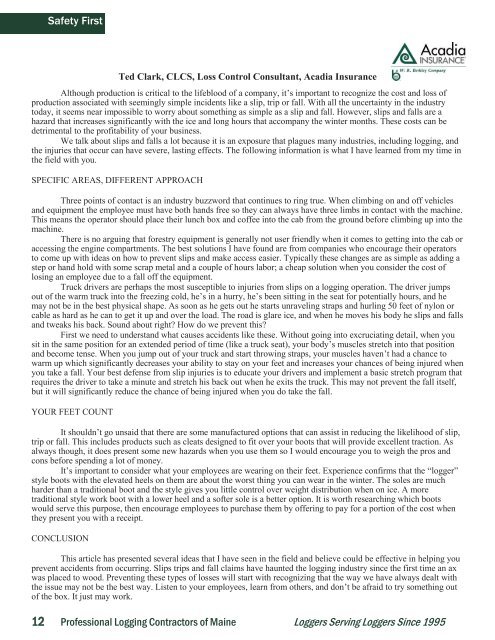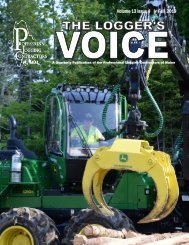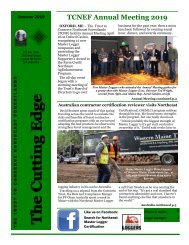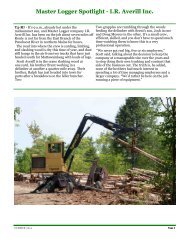PLC Logger's Voice Winter 2017
You also want an ePaper? Increase the reach of your titles
YUMPU automatically turns print PDFs into web optimized ePapers that Google loves.
Safety First<br />
Ted Clark, CLCS, Loss Control Consultant, Acadia Insurance<br />
Although production is critical to the lifeblood of a company, it’s important to recognize the cost and loss of<br />
production associated with seemingly simple incidents like a slip, trip or fall. With all the uncertainty in the industry<br />
today, it seems near impossible to worry about something as simple as a slip and fall. However, slips and falls are a<br />
hazard that increases significantly with the ice and long hours that accompany the winter months. These costs can be<br />
detrimental to the profitability of your business.<br />
We talk about slips and falls a lot because it is an exposure that plagues many industries, including logging, and<br />
the injuries that occur can have severe, lasting effects. The following information is what I have learned from my time in<br />
the field with you.<br />
SPECIFIC AREAS, DIFFERENT APPROACH<br />
Three points of contact is an industry buzzword that continues to ring true. When climbing on and off vehicles<br />
and equipment the employee must have both hands free so they can always have three limbs in contact with the machine.<br />
This means the operator should place their lunch box and coffee into the cab from the ground before climbing up into the<br />
machine.<br />
There is no arguing that forestry equipment is generally not user friendly when it comes to getting into the cab or<br />
accessing the engine compartments. The best solutions I have found are from companies who encourage their operators<br />
to come up with ideas on how to prevent slips and make access easier. Typically these changes are as simple as adding a<br />
step or hand hold with some scrap metal and a couple of hours labor; a cheap solution when you consider the cost of<br />
losing an employee due to a fall off the equipment.<br />
Truck drivers are perhaps the most susceptible to injuries from slips on a logging operation. The driver jumps<br />
out of the warm truck into the freezing cold, he’s in a hurry, he’s been sitting in the seat for potentially hours, and he<br />
may not be in the best physical shape. As soon as he gets out he starts unraveling straps and hurling 50 feet of nylon or<br />
cable as hard as he can to get it up and over the load. The road is glare ice, and when he moves his body he slips and falls<br />
and tweaks his back. Sound about right? How do we prevent this?<br />
First we need to understand what causes accidents like these. Without going into excruciating detail, when you<br />
sit in the same position for an extended period of time (like a truck seat), your body’s muscles stretch into that position<br />
and become tense. When you jump out of your truck and start throwing straps, your muscles haven’t had a chance to<br />
warm up which significantly decreases your ability to stay on your feet and increases your chances of being injured when<br />
you take a fall. Your best defense from slip injuries is to educate your drivers and implement a basic stretch program that<br />
requires the driver to take a minute and stretch his back out when he exits the truck. This may not prevent the fall itself,<br />
but it will significantly reduce the chance of being injured when you do take the fall.<br />
YOUR FEET COUNT<br />
It shouldn’t go unsaid that there are some manufactured options that can assist in reducing the likelihood of slip,<br />
trip or fall. This includes products such as cleats designed to fit over your boots that will provide excellent traction. As<br />
always though, it does present some new hazards when you use them so I would encourage you to weigh the pros and<br />
cons before spending a lot of money.<br />
It’s important to consider what your employees are wearing on their feet. Experience confirms that the “logger”<br />
style boots with the elevated heels on them are about the worst thing you can wear in the winter. The soles are much<br />
harder than a traditional boot and the style gives you little control over weight distribution when on ice. A more<br />
traditional style work boot with a lower heel and a softer sole is a better option. It is worth researching which boots<br />
would serve this purpose, then encourage employees to purchase them by offering to pay for a portion of the cost when<br />
they present you with a receipt.<br />
CONCLUSION<br />
This article has presented several ideas that I have seen in the field and believe could be effective in helping you<br />
prevent accidents from occurring. Slips trips and fall claims have haunted the logging industry since the first time an ax<br />
was placed to wood. Preventing these types of losses will start with recognizing that the way we have always dealt with<br />
the issue may not be the best way. Listen to your employees, learn from others, and don’t be afraid to try something out<br />
of the box. It just may work.<br />
12 Professional Logging Contractors of Maine Loggers Serving Loggers Since 1995


















